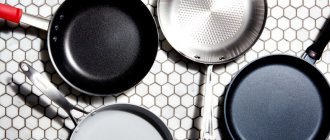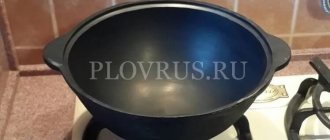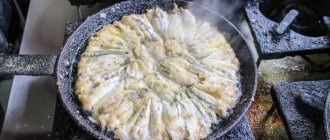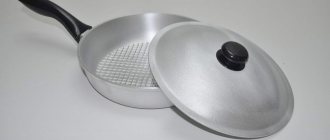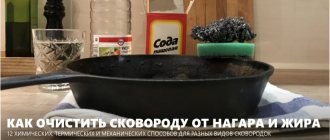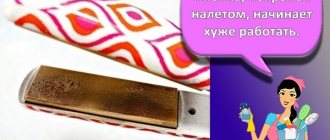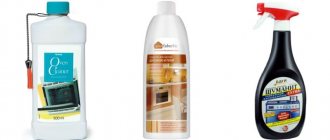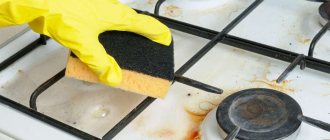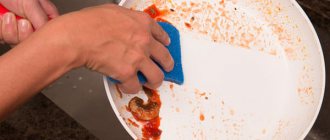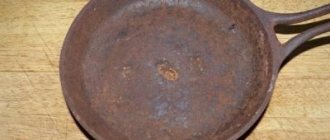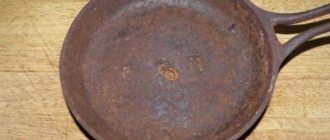Non-stick pans are in great demand. They do not require complex care, and the prepared dishes are tasty and contain a minimal amount of fat. However, over time, the products become dirty and plaque appears. In order not to compromise the integrity of the material, you should learn how to properly clean a non-stick frying pan inside and out.
Methods for cleaning a non-stick frying pan
The cleaning method is selected depending on the degree of contamination of the dishes. Traditional methods are the most gentle, as they do not damage the surface coating of the dishes.
Different substances are used for the outer and inner parts:
- The inside of the frying pan can be easily washed with laundry soap, soda and soda-based substances. In addition, these products are environmentally friendly and not harmful to humans.
- For the outside, a variety of liquid products and special sprays, foams, creams, and gels are used.
What not to use to clean a non-stick frying pan
The non-stick coating continues to properly perform its main function only if there is no damage. It is important that it lasts as long as possible so that you don’t have to get rid of the pan. There are several inappropriate means and methods:
- Citric acid, soda powder, undiluted vinegar, household chemicals with acids and alkalis. Exposure to aggressive chemicals will quickly damage the coating, corroding it along with contaminants.
- Powders and abrasives - they scratch the surface even when washed with a soft sponge.
- The hard side of the sponges, metal brushes and meshes will leave scratches.
- Strong and uneven heating will damage the coating. This is why salt cannot be found among home methods: it gets very hot and can also scratch the surface.
It is important not to use detergents on the inner surface so that the chemicals do not penetrate into the food and then into the human body.
Cleaning inside
The fumes on the inside of the pan are washed off first, since this part interacts with food. The selected substance should not be harmful to health, so cleaning is carried out only with folk remedies.
Mustard powder will quickly and safely remove a small layer of burning and grease. The powder is poured onto a soft sponge, after moistening it in water, and the dirt is wiped off. Then the frying pan is washed in warm water with baby soap.
Laundry soap
You can find laundry soap in every home. This simple remedy will help you effectively get rid of carbon deposits.
Cleaning process:
- Grate 1/4 of a bar of soap.
- The mass is placed in a frying pan and filled with water.
- Place on low heat and heat without bringing to a boil.
- The frying pan along with the soap solution is left to cool.
Be sure to read:
Kitchen grease remover: how to clean kitchen furniture from dirt and stains
After 2 hours, the solution is drained. The dishes are washed thoroughly using a simple detergent and a soft sponge.
Boiling with soda
Soda is the best helper in the kitchen.
It easily breaks down fat deposits, and the dishes acquire their original shine:
- Dissolve 5 tsp in a 1 liter container. soda
- The soda solution is poured into a frying pan and boiled for 20 minutes.
- Remains of burnt food are removed with a soft sponge after the mixture has cooled.
Baking soda + dishwashing liquid
Baking soda mixed with detergent breaks down fats 2 times faster.
Mode of application:
- Add 1 tbsp to the water. l. baking soda and a few drops of detergent, mix everything.
- The solution is poured into a frying pan, put on fire and brought to a boil.
- Remove from heat and leave to cool.
- After 50 minutes, the solution is drained and the pan is thoroughly washed.
To ensure that the cleaning agent is completely washed off, pour plain water into the frying pan, put it on the fire and boil for several minutes.
Soda + stationery glue
The appearance of the dishes will be completely restored if you clean them with soda and the addition of office glue. The glue does not have any effect on the non-stick coating and human health.
To prepare the solution you will need:
- soda – 1/3 pack,
- office glue - 1 tube.
Fill the frying pan halfway with water, add the prepared solution and boil for 45 minutes. Then leave to cool for 3 hours and wash off. If the mixture is left for a day, the effect will be better.
Toothpaste
Tooth powder and paste can be used to easily clean burnt-on food on aluminum pans . A small amount of powder is poured onto the burnt bottom and left for 12 hours.
Then the product is wiped with a rag and washed under water. If necessary, repeat the procedure.
Ethanol
Treating the pan with ethyl alcohol will help remove baked-on greasy stains. Rub the inside of the product with alcohol and leave for an hour. When the fat is peeled off, the product is washed.
Coca Cola
Coca-Cola effectively removes old scale and plaque formed on dishes. Fill the container with Coca-Cola and boil. Then rinse under water.
Be sure to read:
How to clean grease from a hood at home: effective methods and remedies
Removing old stains
If the pan is not cleaned for a long time, it will become covered with a thick layer of fat and burning. Old dirt is more difficult to clean, but it is possible to deal with it. The main thing is not to use products containing abrasive particles, otherwise part of the Teflon or ceramic will be removed along with the dirt.
You can remove old carbon deposits in one of the following ways:
- Coca-Cola is poured into the bowl and, covered with a lid, allowed to boil for 5 minutes. Then set the pan aside and wait until it cools down along with the drink. This method allows you to remove carbon deposits from the pan and get rid of even the oldest and most stubborn fat. After pouring out the soda, the product is cleaned in the usual way.
- Pour 1 tsp into a glass of water. ammonia and borax. The resulting liquid is used to treat old stains and leave to soak. Use a soft washcloth to wash the product with plenty of cold water.
- Squeeze toothpaste onto all stains and spread with a soft cloth. After 15-20 minutes. Clean the surface from carbon deposits and wash well.
- Treat the carbonated surface with ethyl alcohol and leave for a few minutes. Alcohol dissolves even old fat.
Cleaning outside
The best way to clean the outside of a frying pan is to use chemical cleaners. The concentrated product is applied to the surface and left for 15 minutes.
Then the old carbon deposits are washed off with water. To make the cleaning process faster, you can use sprays. If another liquid is used, then when applied to the surface it is thoroughly foamed.
Do not allow chemicals to get on the inside of the container.
Store-bought cleaning products
Store-bought sprays, gels and other cleaning substances may only be used on the outside of cookware.
Rules of use:
- Foam is the fastest-acting remedy. After application to the surface, the contamination dissolves within 15 minutes.
- Gel and cream are thick, highly concentrated substances. They are applied to a dirty surface for 30 minutes.
- The spray is applied to the outside of the product and wait for the time specified in the instructions.
Important! Washing dishes should be thorough after using any cleaning agent.
How and with what to wash old carbon deposits and grease
Fill the pan with 5 liters of water. Add 200 g of baking soda and 2 bottles of liquid glass to it. Place the container on the stove and heat the liquid to maximum. Then submerge the pan in it. Continue heat treatment for 60-90 minutes. Then wait until the composition cools down. Remove the pan from it and wash it as usual.
When carrying out work, do not forget about safety measures. Wear gloves and a respirator to protect your hands and respiratory system from chemicals. Provide drafts in the room.
You can remove old carbon deposits using mustard powder. Pour 250 g of product into a frying pan and pour 1 liter of boiling water. Cover it all with a lid and leave for a day. Then remove dirt with a soft sponge. By the way, you can wash any dishes with mustard on an ongoing basis. This is how our grandmothers often used it. It not only degreases, but also has a powerful bactericidal effect. It is as effective as modern chemicals.
Another method of solving the problem suggests using 9% vinegar. Combine it with water in a ratio of 1:4 and pour into the frying pan. Place the dishes on the stove, wait for the liquid to boil and keep the frying pan on low heat for 2-3 hours. Then pour the vinegar solution into the sink and use a sponge. To prevent the container from having an unpleasant odor after the procedure, boil clean water in it 2-3 times with the addition of lemon (lime) or fresh apple juice.
Baking powder will help get rid of the problem without any risks. Pour a packet of baking powder into the pan. Then pour water to the top. Place the utensils on the stove, bring the liquid to 100 °C and boil for 15 minutes. After this, let it cool and drain. Wash the pan as usual.
Cleaning rules by type of coating
Frying pans are made from a variety of materials. And so that cooking is not complicated by constant burning, you need to follow the rules for caring for dishes.
Teflon is considered the most reliable material. The inner and outer parts of the frying pan are protected from carbon deposits. But even on it, small fat deposits appear over time.
Aluminum
Aluminum products require special care, since the wrong product can damage their surface.
For cleaning, do not use alkaline substances or products with a high content of acids. Also, the integrity of the surface is compromised when aggressive chemicals are used. And the steam emanating from them can cause poisoning.
Be sure to read:
How to clean the outside of a stainless steel kettle: the best folk and chemical remedies
Teflon
A hard sponge or aggressive substances cannot be used to clean Teflon-coated products, since the coating on the surface is very thin and fragile.
To remove traces of carbon deposits, pour water into a frying pan and boil it. Traces of soot will be easier to clean if you add a few drops of detergent to the water.
Ceramic
Ceramic products are very popular among consumers, but such dishes are very difficult to care for and are easily damaged. Due to damage, food begins to burn to the surface.
Cleaning such products is difficult because it must be done carefully. Special products are produced for gentle cleaning of ceramics and safe removal of carbon deposits.
Non-stick
Non-stick frying pans cannot be cleaned with a concentrated solution of citric acid, pure vinegar or chemicals that contain alkali and acid.
The coating deteriorates if the hot product is cooled sharply under cold water.
Cast iron
Products made from cast iron are the most reliable and safe for humans.
They have a long service life. The frying pans are easy to care for; it is enough to occasionally remove carbon deposits from their surface.
Cleaning can be carried out by any method, since the coating has good resistance to abrasive particles and metal. Suitable detergents are substances intended for steel products.
Why does soot form?
When cooking in a frying pan, vegetable oil or animal fat is usually used.
Splashes of fat fall on the surface of the pan, and high temperatures cause the substance to “stick” to the pan, both outside and inside. As you use the frying pan, more and more such spots will appear, and eventually a loose coating will form in the form of burnt fat. This is called carbon deposits, which will require some effort to remove.
Currently, you can find on sale a lot of chemical products for cleaning containers with non-stick coating, but not every housewife has the financial opportunity to make such a purchase. In most cases, gels and powders are expensive, and they also contain strong substances that can cause allergies.
How to restore a Teflon frying pan to its original appearance at home without harming your health? Traditional methods of dealing with burnt fat will come to the rescue.
Preventing carbon deposits
If you regularly take preventive measures against the formation of fat deposits and soot, the need for cleaning will decrease.
Care instructions:
- The pan is washed every time after use.
- Spoons, spatulas and other accessories made of metal cannot be used.
- Excessive overheating will deform the frying pan, so overheating should not be allowed above +250 °C.
- Once a week, the outside of the product is washed with a chemical detergent.
How can the coating of a frying pan become dirty?
When dishes are actively used, they cannot escape contamination. Residues of oil after frying, dough, drops of jam, etc. - every housewife is familiar with this list. Despite the fact that cooking in such a frying pan requires a minimum of fat or oil, it should still be cleaned after each use. And then the question arises for every housewife - how to clean a frying pan with a non-stick coating?
The Teflon coating is easy to scratch, so do not use acids or alkalis.
Important! The non-stick coating is specially designed for ease of care and cooking; resistance to dirt is one of the main qualities. If you notice that the frying pan has become more susceptible to contamination inside, or that it has become more difficult to clean, be sure to take a closer look at the coating applied. Most likely it is damaged. In this case, the frying pan is not recommended for use, especially Teflon. Unfortunately, it needs to be replaced.
The salty way
Do you know how they used to clean frying pans? They poured a thick layer of coarse salt on the bottom, put it in the oven and heated it. After cooling, the salt was removed and the bottom of the dish was wiped with a cloth. No water was used at all. But neither the pancakes nor the cutlets burned. This is how cast iron frying pans acquired non-stick properties.
The method is not suitable for modern non-stick cookware, but its details were used as a basis. Salt is a great fat dissolver, so boiling salted water in a frying pan for 5 minutes gets it spotlessly clean.
The method can be varied - add a little soda to the salt, things will go faster.
Important! Calcination of salt on a dry non-stick surface is prohibited; the coating will crack.
Baking soda is as popular as salt in its ability to dissolve fat. And it removes carbon deposits even better. Let's talk.
Baking Soda: Methods with Variations
Baking soda is the basis for a whole arsenal of home cleaning solutions. Baking soda will also help remove grease from kitchen cabinets. Here's how many options there are.
- 3 liters of water + 50 grams of soda. Use the composition to boil dishes to clean the inside.
- 3 liters of water + 50 grams of soda + 50 grams of shaved laundry soap. Here, laundry soap can be replaced with washing gel. Use the mixture to boil a frying pan while completely immersed. This is a kind of general cleaning for non-stick coatings and the outside of any kitchen utensils. You need to boil for an hour, then wash under running water.
- Composition No. 2 + a bottle of silicate glue. Use as follows: mix all ingredients, wait until completely dissolved. Immerse the burnt pan and simmer for an hour.
- Rinse after. The method is the most general of all general ones. If after such a super treatment the frying pan is not cleaned, it must be thrown away; the item is unsuitable for cooking.
- Carbonated drinks and mineral waters are a ready-made solution for cleaning. Made - they are based on the same soda! Therefore, feel free to pour cola into a frying pan, boil, the effect will be the same as when working with soda.
You can also soak the pan in a solution of soda overnight without resorting to boiling. The next morning, just rinse it with water. But in modern home kitchens, a basin with dishes soaked overnight is hardly appropriate. Not aesthetically pleasing and not modern, don’t you think?
Important! We do not recommend washing non-stick pans with acid solutions - vinegar, citric acid and others. They have a negative effect on the coating and compromise its strength.
An exception to the acid method is cleaning the inside surface with an apple. Cut the apple into two parts, lightly chop the cut surface until the juice comes out, and wipe the dishes after cooking. If there is a large amount of soot, the product does not work.
How to clean rust from a frying pan?
To get rid of rust on a frying pan you need:
- Clean the pan using any method used to remove the layer of fat described above.
- Dry the utensils well
- Place in a preheated oven at 120°C for 40 minutes.
- Take out the frying pan, grease it with vegetable oil, and cover the bottom with foil
- Heat the oven to 230 °C and place the frying pan for 1 hour
- Then, take it out and grease it again with a small amount of vegetable oil.
Keep the pans clean
After this procedure, food should not stick to the surface.
- Regular sand and raw potatoes, which you should rub on the damaged areas, will help you get rid of rust.
- A burnt frying pan can be saved by boiling in a bucket with the addition of 2-3 onions and 3 tsp. baking soda.
Aluminum pans should be washed as usual. First, use regular detergents and cleaning powder, then rinse well. Immediately after cooking, while the pan is still warm, you can rub the outside of the pan with coarse salt to avoid the formation of a thick “coat.”
How to clean a ceramic frying pan from carbon deposits: folk recipes, tips
Food cooked in a frying pan with a ceramic surface rarely burns. But if fumes do form, then you should wash such utensils as carefully as possible. In order to avoid microcracks, it is necessary to avoid contact with cold water, and also to avoid sudden temperature changes. At the same time, it is worth remembering that the above methods, which are suitable for cast iron frying pans, absolutely cannot be used for such a “delicate” surface.
Place 5 tbsp on the ceramic surface. Heat the salt well. Then carefully wash off the contents using a washcloth and detergent. Then, wipe dry with a soft cloth or paper towel.
You can also clean the resulting “coat” on the outside of the frying pan mechanically; for this you should use an attachment in the form of a wire brush for metal for an angle grinder and, of course, do not forget about protection - goggles, a respiratory mask and gloves. Cleaning in this way must be done as carefully and carefully as possible. Thanks to this method, you can clean the pan until it shines, but it is only suitable for the outside of the surface .
If food starts to stick after cleaning, you can heat it with vegetable oil or a little kitchen salt. The salt should be heated in a frying pan for 20 minutes, as soon as it starts to “crackle”, mix well. For a similar procedure, this salt can be used again.
Recommendations for caring for dishes
Any cookware should be washed after it has cooled; you should not expose the non-stick coating to sudden changes in temperature. If you immerse a frying pan in cold water just removed from the stove, it may become deformed, the coating may crack, and further use of such utensils will no longer be safe and ineffective.
It is unlikely that you will be able to stop using a Teflon frying pan, given its well-founded advantages and uniqueness.
Before soaking and boiling, it is better to unscrew or remove the removable handle, or simply do not immerse it in water. Don't forget that handles are often made of a different material and have different care requirements.
Sources
- https://chistyulka.ru/uhod/kak-otmyit-skovorodu-s-antiprigarnyim-pokryitiem-ot-nagara-vnutri
- https://rem.ninja/kuhnya/uhod/ochistit-antiprigarnuyu-skovorodu-ot-nagara.html
- https://posuda-gid.ru/chistka/178-kakpochistit-skovorodu-s-antiprigarnym-pokrytiem
- https://berkem.ru/posuda/kak-ochistit-skovorodku-s-antiprigarnym-pokrytiem/
- https://posudaa.ru/posuda-dlya-prigotovleniya/skovorody/chistim-antiprigarnoe-pokrytie-vnutri-i-snaruzhi
- https://Otbelim.com/vyvedenie-pyaten-i-tsarapin/zhir-i-nagar/kak-ocistit-skovorodu-s-antiprigarnym-pokrytiem.html
- https://uborka-v-dome.ru/pravila-chistki/skovorodka-s-antiprigarnym-pokrytiem.html
- https://zen.yandex.ru/media/id/5db5b83f34808200b0a60071/5dc8eb69e161f40e7bb6c8f5
- https://trudogolikam.ru/bytovye-sekrety/kak-ochistit-skovorodu-ot-nagara-i-zhira-v-domashnix-usloviyax.html
- https://posudaguide.ru/chistka-i-uhod/skovorodki-s-antiprigarnym-pokrytiem-vnutri-i-snaruzhi
- https://nisorinki.net/kak-pochistit-skovorodu-s-antiprigarnym-pokrytiem-vnutri-i-snaruzhi/
The best ready-made products
There is perhaps no easier way than to clean carbon deposits on a Teflon frying pan with a ready-made grease remover. Such products are suitable for removing dirt from the outside of dishes. The following types of funds are used:
- gel and creamy ones - “Antinagar”, “Domestos”. They easily corrode fat and are then removed using an ordinary sponge.
- sprayers – “Mr. Muscle”. Such products are very easy to evenly distribute over the surface of the dishes.
- liquid products – “Milam”, “Shumanit”. They are applied for a long time - about half an hour, after which they are easily removed with a soft sponge.
- foam – “Amway Dish Drops”. A small drop of the product will be enough to clean the carbon deposits.
